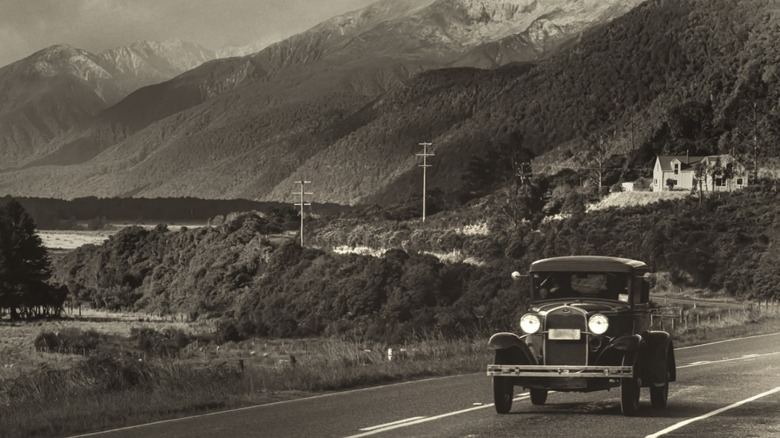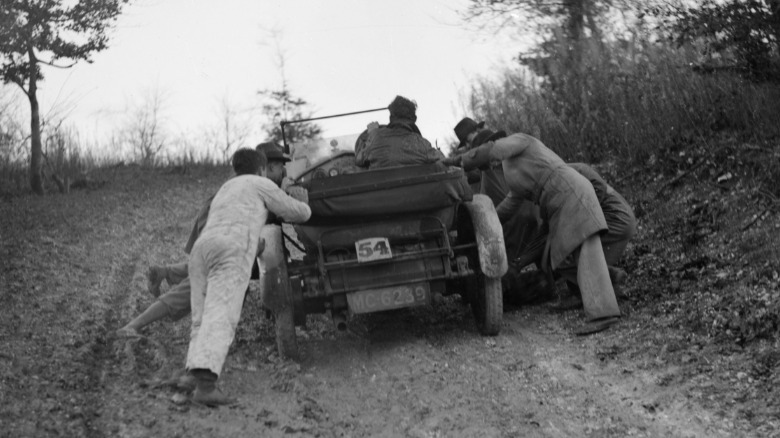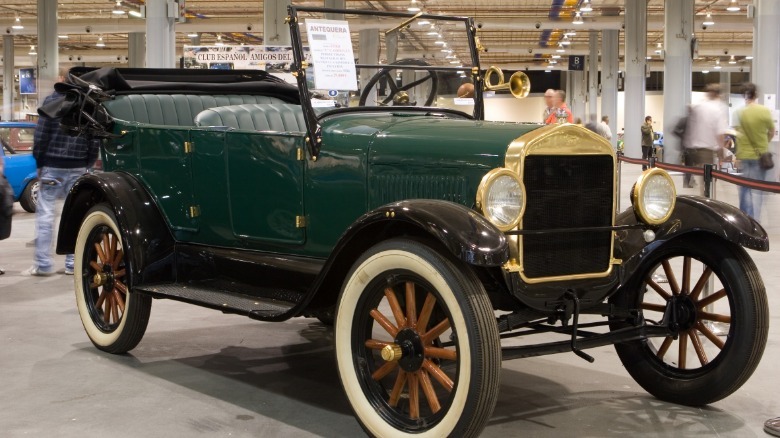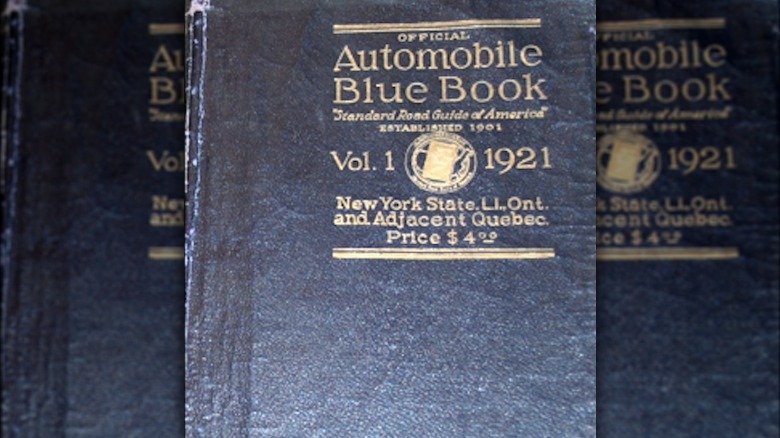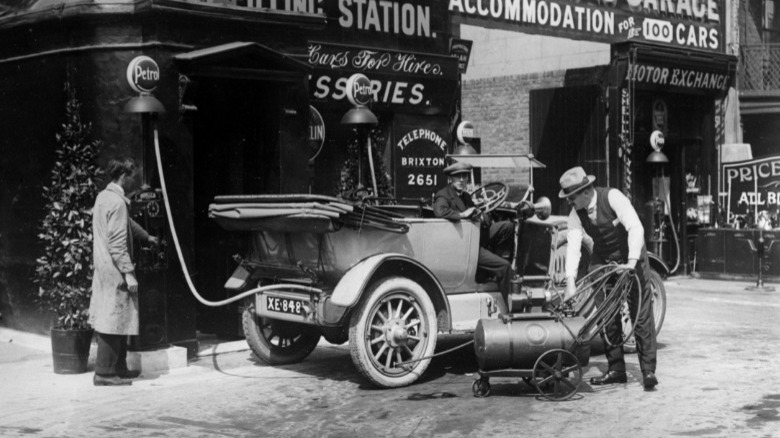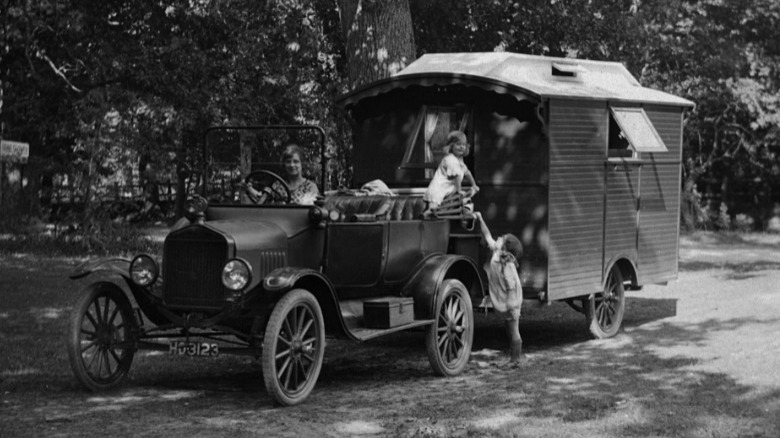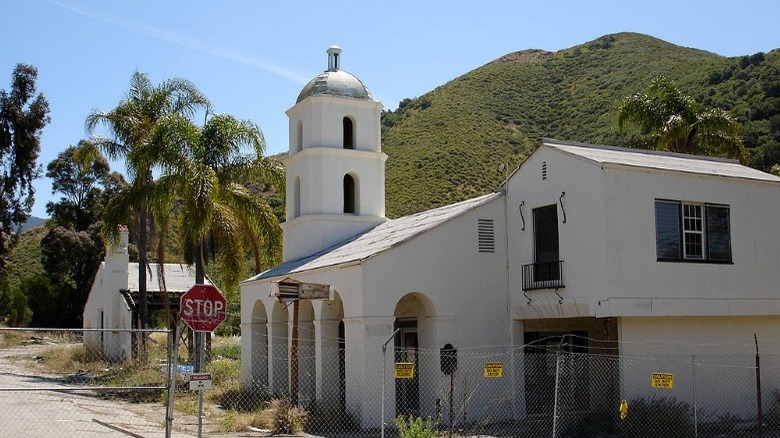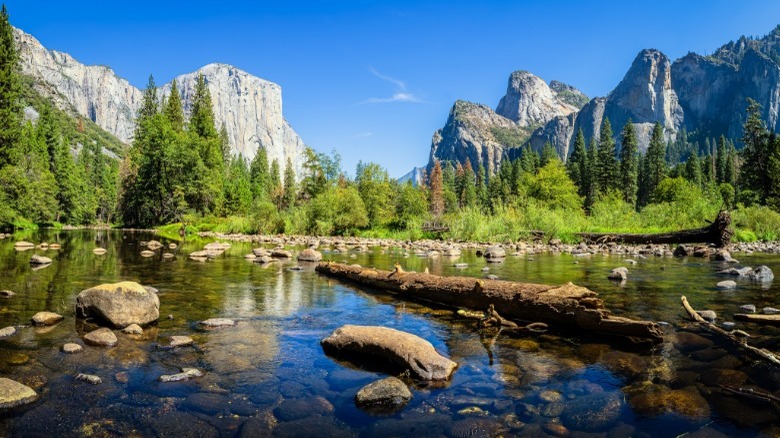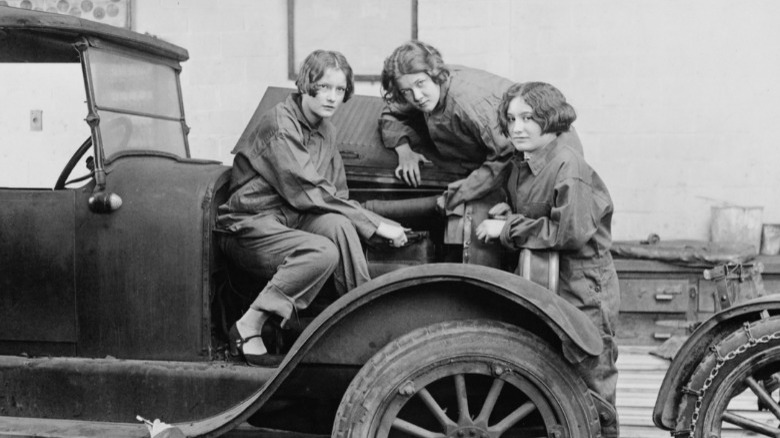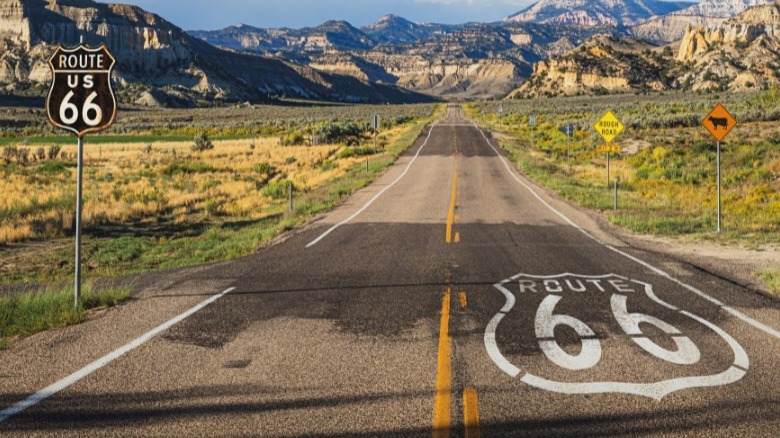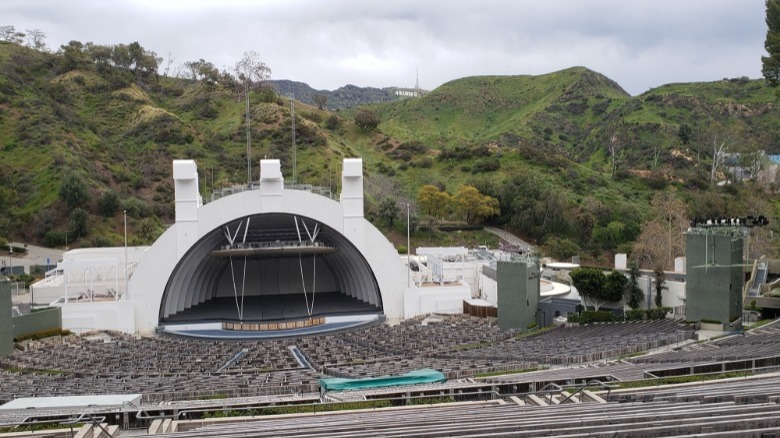What The American Road Trip Was Like 100 Years Ago
There is perhaps no country with a greater connection to the open road than the United States of America. The vast stretches of asphalt that cut through the mountains, prairies, and deserts conjure romantic images for both Americans and admirers from around the world. Today, with modern cars and the sprawling Interstate Highway System, drivers can cross the American continent in just a couple of days. In fact, they could do it in under 26 hours if they so desired (via Road and Track). 100 years ago, however, the great American roadtrip was quite different.
The "speedy, safe transcontinental travel" of President Eisenhower's Interstate Highway System was still some 30 years off, and drive-through restaurants and drive-in cinemas were yet to become the hallmarks of American car culture. For the road trippers of the 1920s, their journeys were not about amenities and convenience but wild, untamed adventure. Here is what the American road trip was like 100 years ago.
It was not leisurely
Driving across the American continent in the 1920s was a real adventure. According to the University of Notre Dame, many roads were unpaved and unnamed. Also, travellers would have to contend with long, muddy passages. Richard F. Weingroff wrote that roads were, "Often little more than trails that were muddy in the rain and dusty the rest of the time."
An unattributed letter found by the University of Notre Dame wrote of a trip from Long Beach, California, to Chagrin Falls, Ohio — a journey of well over 2,000 miles. The author, speculated to be a woman in her early 20s, described the hardships of crossing Niland, California, "Got off road to Niland [California]. We went up a sandy mountain & thru revines on low mostly. About 50 miles bad road all up grade. We struck civilization just before dusk. We sure was glad to see some one. We went 100 miles and never saw a dwelling. Sand and more sand. We camped beside a well all alone near a store."
Many people were driving a Ford Model T
Produced from 1908 to 1927, the Ford Model T revolutionized travel for millions of Americans. According to History, the Ford Model T was owned by a majority of Americans, many of whom were from rural areas and enjoyed a new level of connectivity thanks to Henry Ford's iconic automobile. Made of strong, lightweight vanadium alloy steel, the Model T was a triumph of simple yet effective engineering. But what really distinguished the car from its peers was Ford's manufacturing process. The Model T was made on the world's first moving assembly line, which enabled workers to produce a whole Model T in just five hours and 56 minutes.
Perhaps the Model T's strongest feature for American roadtrippers was its generous ground clearance, which was proven most famously not in the rugged terrain of the American west, but in the craggy beauty of the Scottish Highlands. In 1911, the son of a Scottish car dealer drove a Model T to the summit of Ben Nevis, the highest peak in the United Kingdom at 4,406 fet (via Britannica). Driving in a zig-zag pattern, the car was able to cover rocks, bogs, and snow, reaching the summit in five days. The stunt was so successful that over 14,000 Model T cars were sold throughout the United Kingdom.
The Official Automobile Blue Book was the road trip bible
With GPS and extensive signage, it's pretty hard to get lost these days. This is generally a very good thing; getting lost is awful. But there are those who lament the ease of modern travel. Screenwriter and director Harmony Korine said, "You can't make a road movie anymore because everyone has GPS. It's impossible to lose yourself anymore."
If Korine wants a real challenge, he may want to ditch his smart phone and get a copy of the "Automobile Blue Book," which was an indispensible guide for motorists in the early 20th century. According to National Geographic, the book contained hundreds of routes complete with thorough directions that listed various landmarks. The book had more personality than the average Google Maps search, too. Korine would likely approve of passages such as this: "True, the unexpected happens in those less developed and more sparsely settled sections of the country — but those unforeseen occurrences, seldom dangerous or serious, are the very thing that give romance and variety to a Western trip."
According to the geographer John Bauer, the "Automobile Blue Book" was referenced so widely that it may have shaped the state and federal highways built in the ensuing decades.
Gas cost around 30 cents a gallon
According to the Energy Information Administration (EIA), a gallon of gas cost 30 cents in 1920. According to US Inflation Calculator, that is roughly $4.17 in 2021 dollars, which is a cumulative inflation rate of 1289.7%. That is higher than the average national gas price in January 2021, which the EIA estimated at $3.29.
In studying a diary kept by a cross-country motorist in 1920, the University of Notre Dame speculated that diarist's family spent around 40 cents per gallon, which was likely to have been a major part of their trip's $150 expense, which is around $2,084.61 in 2021 dollars. If the diarist's family really did pay 40 cents per gallon, they were paying a premium compared to the prices in the near future. Statistics from the Office of Energy Efficiency & Renewable Energy shows that from 1929 until 1949, the average gas price stayed between 21 and 27 cents per gallon.
Many road trippers stayed in campsites
Campsites catered to motorists of all stripes, including presidents and industry titans. In 1921, President Warren Harding dined at a camp in Maryland with Henry Ford, Thomas Edison, and other leading figures of industry (via Atlas Obscura). Ford and Edison were members of the so-called "Four Vagabonds," which included Henry Firestone, the tire industrialist, and John Burroughs, the nature writer.
According to The Henry Ford, the Four Vagabonds went on yearly excursions through states such as West Virginia, Tennessee, North Carolina, and Virginia. They also visited the Everglades, Adirondacks, and Catskill mountains. These sweeping road trips are better described as caravans, as the Four Vagabonds would travel in as many as 50 vehicles, which included a mobile kitchen and trucks filled with the lastest camping equipment.
But again, car camping wasn't a elite pursuit. Ordinary road trippers could access campsites across the country, which were usually located in parks and other natural areas. Campers are said to have shared a playful comaraderie, addressing each other by nicknames rather than pry about their personal lives. This was part of a nomadic spirit that was central to many trippers' journeys.
If drivers were going through San Luis Obispo, they could have stayed in the world's first motel
Perhaps the main reason for campsites' popularity was that the 1920s road tripper had no cheap alternatives available to them. However, in the California town of San Luis Obispo, which is about halfway between Los Angeles and San Francisco, an establishment called the Milestone Mo-Tel Inn was opened in 1925 (via Smithsonian).
The brainchild of architect and developer Arthur Heineman, the Milestone was America's very first motel, which is a portmanteau of motor and hotel. Unlike modern motels, the Milestone wasn't built on the cheap. Kristin Jackson wrote, "It cost $80,000 to build in its ornate Spanish-mission style, with a three-tiered bell tower, white pillars, and a tree-fringed courtyard ... In those days most American car travelers still were staying in campgrounds or tiny wood cabins."
The motel consisted of a few dozen bungalows and a series of garages, costing motorists just $1.25 per night, which is roughly $19.85 in 2021 dollars, according to US Inflation Calculator. Despite these reasonable prices, the Milestone was hit hard by the Great Depression and faced local competition from even cheaper establishments. After many years in business, the renamed "Motel Inn" shut for business in 1991. The building still stands in San Luis Obispo, but it is a shadow of its former self.
Many would have enjoyed the new National Park Service
The Yellowstone National Park Protection Act of March 1, 1872, made Yellowstone the world's first national park. According to History, the act allocated 1,221,773 acres of land to the public park, which went against the norm of privatising land in the American West. This was followed by the National Park Service, a federal bureau created by President Woodrow Wilson on August 25, 1916. Dubbed the "National Park Service Organic Act," the new bureau was tasked with protecting the then-35 parks across the United States, which included Yosemite, California; Crater Lake, Oregan; and Glacier, Montana.
Cars allowed Americans to visit these wonders with greater ease than ever before; this charged a passion for the country's national parks, which documentarian Ken Burns referred to as "America's best idea." In the 1920s, motorists in the west had the lion's share of parks, as the only national park east of the Mississippi River at that time was Acadia National Park in Maine (via NPS). Much has changed since then. Today, the National Park Service looks after 417 parks and monuments across the country, attracting some 327 million visitors in 2019.
Car reliability was improving, but there were still common issues
According to Iowa PBS, the first cars at the turn of the century were considered toys because of how impractical and unreliable they are. This changed with cars such as the Ford Model T, but common issues remained. For example, during the winter months, motorists were advised to drain the water from their radiators to avoid the water freezing, expanding, and damaging the components.
The University of Notre Dame diarist wrote of tire issues: "It has rained all day. About 12 miles from Cleveland the darned tire had another puncture. Just got out of the main part of Cleveland & the front left tire went down. Before we got to Lorain the front left tire blew out. Dad said let it go so we drove on it & the left hind tire punctured so we took it off & went on the rim. We got stuck in the mud in Chagrin Falls & walked a couple blocks to Aunt Eustella's at 10:30 P.M."
However, one advantage was the simplicity of the engineering. Unlike the complex electrical components in modern cars, which would require specialist diagnostic tools to fix, the cars of the 1920s required a comparatively basic mechanical understanding. Futhermore, despite these cars having far fewer safety features, cars of the era had low top speeds, and the roads were much less crowded.
In 1926, Route 66 would transform the U.S. road network
Connecting Chicago with Los Angeles, the 2,448-mile Route 66 was the first road of its kind (via Legends of America). The sweeping, epic road was a vital artery for truckers and road trippers, and it soon became a national icon — the quintessential American road trip.
However, President Eisenhower's 1956 Federal Highway Act rendered Route 66 obsolescent. According to the Federal Highway Administration, Eisenhower was inspired by the German autobahns he had experienced during his time as Supreme Allied Commander in World War II. Eisenhower's new Interstate System introduced four-lane highways that were objectively better than Route 66, yet they all but destroyed the romance of the route's towns, diners, and attractions.
Although just 85% of Route 66 remains, the allure has not gone. People from around the world still visit at least some of the route, enjoying sites such as Roy's Motel and Cafe in Amboy, California, with its classic neon sign punctuating the sparse desert landscape.
There were many new landmarks to visit
In the 1920s, roadtrippers were able to a visit growing number of enduring American landmarks. In Washington, D.C., the Lincoln Memorial was opened on May 30, 1922 (via Britannica). A month and a half later, on July 11, the Hollywood Bowl opened in Los Angeles, which was designed by the Lloyd Wright family and kicked off its 100-year history with performances by the Los Angeles Philharmonic Orchestra (via Discover Los Angeles).
Just south of Los Angeles, the San Diego Zoo was enjoying its sixth year of business in 1922. A year later, in 1923, entry for an adult non-member was just 10 cents, while children went in completely free, according to the San Diego Zoo Wildlife Alliance Library. In 2021 dollars, that is just $1.63, which is about 38 times cheaper than San Diego Zoo's 2021 price for a 1-day pass, which comes in at $62!
Also new was Knott's Berry Farm, although modern Americans wouldnt recognise it. It wasn't a theme park but a simple fruit stand, and it wouldn't become a themed attraction until 1947 (via Knott's Berry Farm).
